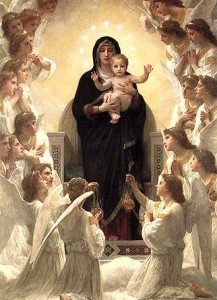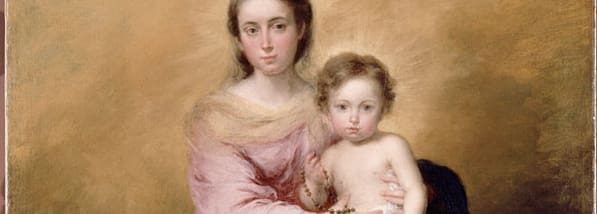 Dear Father John, I am a convert to the Catholic faith, and I still have difficulties with Mary. Don’t get me wrong – I believe all the dogma and doctrine fully, but when it comes to praying to Mary, I don’t seem to get it. What role is she supposed to have in my pursuit of holiness and spiritual growth?
Dear Father John, I am a convert to the Catholic faith, and I still have difficulties with Mary. Don’t get me wrong – I believe all the dogma and doctrine fully, but when it comes to praying to Mary, I don’t seem to get it. What role is she supposed to have in my pursuit of holiness and spiritual growth?
We have already looked briefly at the source of Mary’s greatness and the power of her presence. Now we are ready to look at the two other ways she exercises her spiritual motherhood in our lives: her example of holiness and her prayerful intercession on our behalf.
Praying to Mary: Mary Shows Us the Way
The popes and the most revered spiritual writers throughout the centuries have all emphasized Mary’s example above every other aspect of Marian devotion. She, the first Christian, is also the model Christian. Throughout the Gospels, she is very discrete. She never tries to steal the spotlight from her son and Lord, yet her own role cannot be ignored. As she serves and follows Jesus, she shows us, with great simplicity, how to do the same. When the Archangel Gabriel brings the message of the Annunciation, she shows us the beauty and force of virtues like humility, obedience, and trust in God. When she speeds off to help her elderly cousin Elizabeth with her pregnancy and birth, and when she saves the wedding at Cana from social disaster, she shows us what true, self-forgetful, creative charity really looks like. With the words of the Magnificat, she shows us what it really means for a creature to love and praise her Creator. As she gathers with the frightened Apostles in the Upper Room, waiting for the Holy Spirit, she embodies the virtue of prayer and love for the Church. Perhaps most eloquently of all, as she stands at the foot of the cross and accompanies Jesus to the bitter end of his passion, she reveals the true countenance of faith, courage, patience, and perseverance.
It is easy to list her exemplary virtues. But to benefit from them, we have to do more than read the list. We have to meditate on her words and example, giving them space to resonate in our hearts. Like tiger cubs, we have to watch our Mother vanquish our spiritual enemies so as to learn how to do the same.
I recently received an email from a friend who described a painful situation. A relative had committed suicide, causing shockwaves throughout the large extended family. My friend made a beautiful comment on the challenge of dealing with that, a comment which impressed me deeply: “I can’t imagine Mary’s Agony of the loss of Jesus. Jesus gives way beyond my comprehension. There is so much to learn and I only feel I am skimming the surface. I pray to do his will.” In the midst of that suffering and pain, it was Mary’s example that shone like a bright moon on a cold, dark night, giving hope and strength. Mary is not invoked by Catholics as “Star of the Sea” for nothing.
Mary Prays for Us
Besides her presence and her example, we also need to learn to depend on her intercession. The “pray for us, O Holy Mother of God” that we recite in the Hail Mary is the model of a child’s confident plea. We should expect great things from the mother of our Lord, who is also our mother in the order of grace. It is no coincidence that in the game of Chess as played in the Western world, the Queen is the most powerful piece on the board. According to most Chess historians, the game originated in India, and was popularized in Persia and Arabia before coming into Europe through Muslim Spain in the Middle Ages. In the Indian version, the Queen piece could only move one square, and in fact it was not named Queen at all – it was called the Mantri, or minister. But as the game took on its modern form in Catholic Europe, the piece next to the King became more powerful and was renamed the Queen. At the same time, the magnificent medieval cathedrals were being constructed, often named in honor of “Our Lady” (Notre Dame), the Blessed Virgin. The concept of a good and powerful Queen who would look after her subjects’ needs in the King’s court was tightly entwined with the longstanding role that Mary had played in the Church (the earliest recorded extra-biblical Christian prayer is a prayer asking for protection from the Blessed Virgin Mary, the sub tuum presidium). When Jesus was dying on the cross, he entrusted John, the representative of the whole future Church, to Mary’s care. And ever since then, Christians have leaned, happily and fruitfully, on Mary’s intercession.
In a recent discourse, Pope Benedict XVI recalled this intercessory role when he commented on the life of St. Germanus of Constantinople. In the eighth century, that city, which had been the capital of the Christian Roman Empire since 325 AD, was under siege by Muslim armies. The siege lasted an entire year, and only the holy Patriarch was able to convince the emperor to keep up his resistance. Every day during the siege, St. Germanus led a religious procession along the battlements all along the city walls. In the procession, the faithful prayed and sang, carrying in honor a relic of the True Cross (the cross on which Jesus was crucified) and an image of the Mary, the Mother of God. “In fact,” Pope Benedict explained, “Constantinople was liberated from the besiegement. The adversaries decided to permanently let go of the idea of establishing their capital in the city that was the symbol of the Christian empire, and the appreciation for divine help was extremely great among the people” (Wednesday Catechesis, 29 April 2009). This is only one of countless examples of the power of Mary’s intercession on our behalf.
Her presence, her example, her intercession – these are the three pillars of Marian devotion, the three ways in which she wants to have a role in our spiritual growth. In our next post, we’ll get practical and list a few ways to let her do that.
Yours in Christ, Father John Bartunek, LC
+
Art for this post on a convert struggling with praying to Mary: Regina Angelorum (The Queen of the Angels), William-Adolphe Bouguereau, 1900, PD-US published in the U.S. prior to January 1, 1923, Wikimedia Commons.





